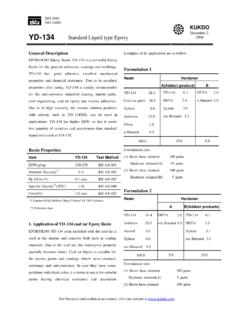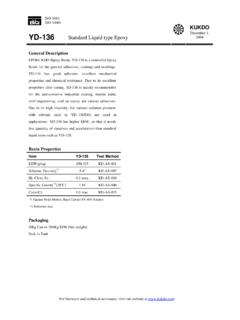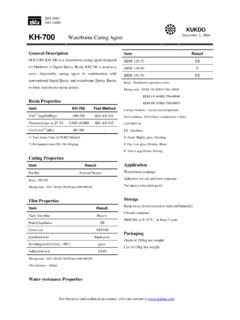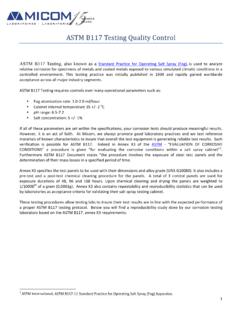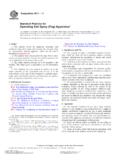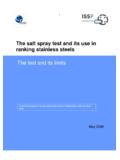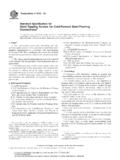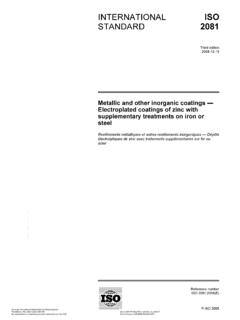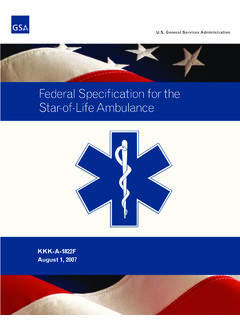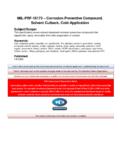Transcription of ·What is polyurea? ·Can anyone apply polyurea? …
1 What is polyurea ? polyurea is an organic polymer that is the reaction of isocyanate with an amine terminated polyether resin, forming a plastic-like or rubber-like compound that may be used in many of the same ways as older technologies - polyurethane, epoxy, vinyl ester, neoprene; to name a few. Can anyone apply polyurea ? polyurea requires special training and equipment for field application, whether used as joint filler or as a field applied coating. VersaFlex has an ongoing program of contractor training in place. There are qualified applicators in all regions of the and an expanding network of qualified applicators throughout the world. Where can polyurea be used? As a general rule, VersaFlex polyurea can be employed to contain any substance that may be directly discharged into normal sanitary sewer systems.
2 It may be easier to give examples of environments where polyurea should not be used. As a general recommendation for constant exposure to direct chemical attack VersaFlex polyurea products may not be installed for attack by: Halogenated Solvents: 1. Carbon tetrachloride 2. Chloroform 3. Methylene chloride 4. Tetrachloroethane 5. Trichlorethene 6. Trichloroethane Non-Halogenated Solvents And Ketones: 1. Acetone 2. Acetonitrile 3. Acetophenone 4. Benzene 5. Butanol 6. Camphor oil 7. Cyclohexanone 8. Diethyl ether 9. Diisobutyl ketone 10. Ethyl acetate 11. Hexane 12. Methyl ethyl ketone 13. Methyl isobutyl ketone 14. Pentane 15. Phenol 16. Toluene 17. Xylene Acidic compounds with a total composite pH range equal to or below 4.
3 Basic compounds with a total composite pH range equal to or above 11. Note: Non-aqueous (anhydrous and anhydride compounds in granular, crystalline, or powder form) protected by an air drying system may be contained by polyurea . Consult VersaFlex. Amine Attacking And Amine Containing Compounds Strong, inorganic acids, organic acid halides, aldehydes, isocyanates, organic anhydrides. 1. Aminoethylethanolamine 2. Aniline 3. Ethylamine 4. Methylamine 5. Pyridine 6. Toluenediamine What kind of temperatures will polyurea withstand and will it burn? VersaFlex polyureas begin to develop their physical properties within minutes of application. Among several very desirable properties are their quick gel time and their glass transition temperatures that average -40.
4 Degrees F and +480 degrees F. Heat of deflection under no load is +250 degrees F. Safe upper limit of working temperature is +350 degrees F, under no load. polyurea will exhibit thermal shock debonding when subject to repeated periodic blasts of live steam. While polyurea has high glass transition and heat of deflection temperatures, it will burn when exposed to direct flame. It will self extinguish when flame is removed. Is polyurea hard or soft? polyurea may be either hard or soft depending on the particular formulation and the intended use. Durometer ratings may range from Shore A 30 to Shore D 80. What is polyurea 's abrasion resistance? VersaFlex has run abrasion resistance testing according to ASTM D 4060 using the most aggressive abrader, the H-18 wheel.
5 The abrasion loss is as noted in our material specification data sheets for the appropriate material. This test was utilized because it most nearly typifies the type of abrasion attack found in industrial environments. The industry standard testing for polyurethanes uses the abraser CS-17 wheel. This wheel is a much smoother, less abrading mechanism than the abovementioned H-18 abrader wheel. The most severe utilitization of polyurethanes is found on parking deck coating systems. The hard polyurethane topcoats used in these systems generally have CS-17 losses between 5 - 10 milligrams. FSS 45DC and FSS 50DM report H-18 loss between 180 and 250 milligrams. This loss is actually much less severe than a loss of 5 10 milligrams on the CS-17 wheel.
6 How well does polyurea adhere to steel? VersaFlex polyurea may be applied to properly prepared A-36 metal substrates. The metal should be blasted to Near White or White, and have a blast profile of 5 mils. Adhesion values will exceed 1000 psi without using primer. What factors should be considered about polyurea 's ability to adhere to concrete? There is no hard and fast number that is useful to the designer. Generally, an adhesion value is a compromise between the type and condition of concrete substrate, the stresses placed upon the membrane prior to project completion, and the requirements of the membrane to withstand in-place use stresses. Where possible, concrete should have all surface paste removed and be free of laitance of any kind.
7 A texture similar to 80-grit sandpaper as a minimum is desirable. Since concrete has low tensile properties, especially at the surface faces of large plan areas, one rule of thumb is to expect adhesion to range around ten percent (10%) of ultimate compressive strength of the concrete. The best that can be expected is in the range of 350 psi to 450 psi for 4,000 psi concrete properly cured and of sufficient age to acquire its maximum physical properties. What is the life expectancy of a polyurea spray elastomer system? The following letter by Dudley Primeaux, Primeaux and Associates, was made in response to numerous inquiries for an answer to the probable life expectancy of polyurea when subjected to immersion in salt water and polyurea subjected to ultraviolet light.
8 The original polyurea formulations alluded to in this letter are those that VersaFlex uses in manufacturer of its aromatic and aliphatic spray materials. Note: Dudley Primeaux is the holder of several patents for polyurea Technology secured while he was the lead chemist for Texaco Chemicals and Huntsman Corporation. Mr. Primeaux is currently employed as a consultant and has been president of the polyurea Development Association. The testing processes cited in this letter are those that are current industry standards. The evaluations and conclusions drawn in this letter are those of Mr. Primeaux and are considered the most expert opinions available within the industry. (Electronic File of Letter from Dudley Primeaux, Primeaux and Associates, to David Cerchie, President, VersaFlex Incorporated).
9 May 24, 2002. Mr. David Cerchie VersaFlex, Inc. 3145 Broadway Kansas City, MO 64111. Dear David: A question has recently been asked as to the life expectancy of a polyurea spray elastomer system as it relates to an application in an immersed saltwater environment. While this question is really not new to the technology, it seems that there has not been any published data or information to support any direct claims that may have been made. But we still would like to know, How Long Will it Last ? As you are aware, the polyurea spray elastomer technology is relatively new to the industry with respect to conventional polyurethane and epoxy type coating systems. Since the development in 1986 and first commercial use in 1988, true life history is o-nly slightly over 10 years.
10 This has provided somewhat of a brick wall if you will as to the real performance of the material. There is data and information available o-n the technology though that might suggest the long-term performance. This data includes accelerated testing o-n the technology compared to the basic physical properties. The first most common testing with regard to accelerated exposure is weatherometer testing. During the development work o-n the polyurea technology at Texaco Chemical Company, several aromatic based polyurea systems were exposed to ASTM G 53 (Practice for operating Light- and Water-Exposure Apparatus (Fluorescent UV-Condensation Type) for Exposure of Nonmetallic Materials). This has commonly been referred to as accelerated weatherometer testing.
